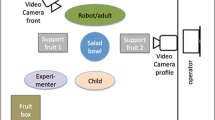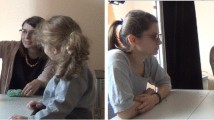Abstract
This study proposes an innovative device specifically designed for investigating the ability of children with autism spectrum disorder (ASD) to test the intention of a partner in a dyadic interactive game. Twenty one children with ASD were exposed to both a contingent and a noncontingent interaction condition with either a human agent or the Robonova robot as partners. The statistical analysis indicates a strong tendency toward a significant higher frequency of testing behaviors in the robot noncontingent condition and no difference between the two groups (robot/human) for the contingent condition. Children with ASD showed significantly more eye gaze to the robot compared to the human agent in both contingent and noncontingent conditions, but no difference in affect was found. The high level of initiations recorded in all conditions suggests that the game has a high motivational value for ASD children. Further longitudinal studies should investigate if such synchronous interaction games lead to improved shared intentionality in children with ASD.




Similar content being viewed by others
References
Asendorpf JB, Warkentin V, Baudonnière PM (1996) Self-awareness and other-awareness II: mirror self-recognition, social contingency awareness, and synchronic imitation. Dev Psychol 32:313–321
Baron-Cohen S (2001) Theory of mind in normal development and autism. Prisme 34:174–183
Baron-Cohen S, Wheelwright S, Hill J, Raste Y, Plumb I (2001) The “Reading the mind in the eyes” test revised version: a study with normal adults, and adults with asperger syndrome or high-functioning autism. J Child Psychol Psychiatry 42(2):241–251
Billard A, Robins B, Dautenhahn K, Nadel J (2006) Building Robota, a mini-humanoid robot for the rehabilitation of children with autism. RESNA Assist Technol J 19(1):37–49
Bird G, Leighton J, Press C, Heyes C (2007) Intact automatic imitation of human and robot actions in autism spectrum disorders. Proc Biol Sci 274:3027–3031
Boccanfuso L, O’Kane JM (2011) CHARLIE: an adaptive robot design with hand and face tracking for use in autism therapy. Int J Social Robot 3:337–347. doi:10.1007/s12369-011-0110-2
Charman T, Baron-Cohen S (1994) Another look at imitation in autism. Dev Psychopathol 6:403–413
Cabibihan JJ, Javed H, Ang M Jr, Aljunied SM (2013) Why robots? A Survey on the roles and benefits of social robots for the therapy of children with autism. Int J Soc Robot 5(4):593–618. doi:10.1007/s12369-013-0202-2
Congiu S, Schlottmann A, Ray E (2010) Unimpaired perception of causality, but impaired perception of animacy in high-functioning children with Autism. J Autism Dev Disord 40(1):39–53
Dawson G, Adams A (1984) Imitation and social responsiveness in autistic children. J Abnorm Child Psychol 12:209–226
Diehl JJ, Schmitt LM, Villano M, Crowell CR (2012) The clinical use of robots for individuals with autism spectrum disorders: a critical review. Res Autism Spectr Disord 6(1):249–262
Duquette A, Michaud F, Mercier H (2007) Exploring the use of a mobile robot as an imitation agent with children with low functioning autism. Auton Robots Special Issue Soc Assist Robot 24(2):147–157
Feil-Seifer D, Matarić MJ (2005) Defining socially assistive robotics. In: 9th IEEE international conference on rehabilitation robotics, 2005 (ICORR 2005), pp 465–468
Gergely G, Watson JS (1999) Early socio-emotional development: contingency perception and the social-biofeedback model. Early Soc Cognit 60:101–136
Gordon RM (1996) ‘Radical’ simulationism. In: Carruthers P, Smith PK (eds) Theories of theories of mind. Cambridge University Press, Cambridge, pp 11–21
Kozima H (2013) Cognitive granularity: a new perspective over autistic and non-autistic styles of development. Jpn Psychol Res 55(2):168–174
Kozima H, Nakagawa C, Yasuda Y (2005) Interactive robots for communication-care: a case-study in autism therapy. In: IEEE international workshop on robots and human interactive communication
Lord C, Risi S, Lambrecht L, Cook EH, Leventhal BL, DiLavore PC, Pickles A, Rutter M (2000) The autism diagnostic observation schedule–generic:a standard measure of social and communication deficits associated with the spectrum of autism. J Autism Dev Disord 30(3):205–223
Meltzoff AN (1990) Foundations for developing a concept of self: the role of imitation in relating self to other and the value of social mirroring, social modelling, and self practice in infancy. In: Cicchetti D, Beeghly M (eds) The self in transition: infancy to childhood. University of Chicago Press, Chicago, pp 139–164
Meltzoff AN, Decety J (2003) What imitation tells us about social cognition: a rapprochement between developmental psychology and cognitive neuroscience. Philos Trans R Soc B 358:491–500
Meltzoff AN, Brooks R, Shon AP, Rao R (2010) “Social” robots are psychological agents for infants: a test of gaze following. Neural Netw 23(8–9):966–972
Nadel J, Bottai B (1999) Imitation and touch in communication with autistic children. In: Paper presented at The Annual Touch Research Symposium, SRCD, Albuquerque
Nadel J (2002) Imitation and imitation recognition: functional use in preverbal infants and nonverbal children with autism. In: Meltzoff AN, Prinz W (eds) The imitative mind: development, evolution, and brain bases. Cambridge University Press, Cambridge, pp 63–73
Nadel J (2004) Do children with autism understand imitation as intentional interaction. J Cognit Behav Ther 4(2):165–177
Pierno AC, Mari M, Lusher D, Castiello U (2008) Robotic movement elicits visuomotor priming in children with autism. Neuropsychologia 46:448–454
Pop C, Simuţ R, Pintea S, Saldien J, Rusu A, David D, Vanderfaeillie J, Lefeber D, Vanderborght B (2013) Can the social robot Probo help children with autism to identify situation-based emotions? A series of single case experiments. Int J Human Robot 10(3):1350025
Premack D (1990) The infant’s theory of self-propelled objects. Cognition 36:1–16
Ricks DJ, Colton MB (2010) Trends and considerations in robot-assisted autism therapy. In: Proceedings of the IEEE international conference on robotics and automation (ICRA), pp 4354–4359
Robins B, Dautenhahn K (2014) Tactile interactions with a humanoid robot: novel play scenario implementations with children with autism. Int J Soc Robot. doi:10.1007/s12369-014-0228-0
Scassellati B (2005) Quantitative metrics of social response for autism diagnosis. In: Proceedings of the 14th IEEE international workshop robot human interaction and commununication (RO-MAN 2005), pp 585–590
Scassellati B, Admoni H, Matarić M (2012) Robots for use in autism research. Annu Rev Biomed Eng 14:275–294
Sevlever M, Gillis JM (2010) An examination of the state of imitation research in children with autism: Issues of definition and methodology. Res Dev Disabil 31:976–984
Simut R, Pop C, Vanderfaeillie J, Lefeber D, Vanderborght B (2012) Trends and future of social robots for ASD therapies: potential and limits in interaction. In: International conference on innovative technologies for autism spectrum disorders (ASD): tools, trends and testimonials
Sloetjes H, Wittenburg P (2008) Annotation by category: Elan and ISO DCR. In: Proceedings of the 6th international conference on language resources and evaluation (LREC 2008)
Snijders JTh, Tellegen PJ, Laros JA (1989) Snijders-Oomen non-verbal intelligence test, SON-R \(5\frac{1}{2}-17\). Wolters-Noordhoff, Manual and research report. Groningen
Tager-Flusberg H (1996) Current theory and research on language and communication in autism. J Autism Dev Disord 26:169–172
Tapus A, Peca A, Aly A, Pop C, Jisa L, Pintea S, Rusu A, David D (2012) Children with autism social engagement in interaction with Nao, an imitative robot. A series of single case experiments. Interact Stud 13(3):315–347
Tellegen PJ, Laros JA (1993) The Snijders–Oomen nonverbal intelligence tests. General intelligence tests or tests for learning potential? In: Hamers JHM, Sijtsma K, Ruijssenaar AJJM (eds) Learning potential assessment: theoretical, methodological and practical issues. Swets & Zeitlinger B.V, Amsterdam, pp 267–283
Tiegerman E, Primavera L (1981) Object manipulation: an interactional strategy with autistic children. J Autism Dev Disord 11:427–438
Vanderborght B, Simut R, Saldien J, Pop C, Rusu A, Pintea S, Lefeber D, David D (2012) Using the social robot probo as social story telling agent for children with ASD. Interact Stud 13(3):348–372
Williams JHJ (2009) Copying strategies by people with autistic spectrum disorder: why only imitation leads to social cognitive development. In: Nehaniv C, Dautenhahn K (eds) Imitation and social learning in robots, humans and animals. Cambridge University Press, Cambridge, pp 199–216
Acknowledgments
The authors thank the Therapy Center-Împreună pas cu pas, the children that participated in the study and their parents, which made this study possible. This work has been supported by the CNCSIS-Bucharest, Romania project PN-II-IDPCE-2011-3-0484-Exploring Robot-assisted therapy for children with ASD.
Author information
Authors and Affiliations
Corresponding author
Rights and permissions
About this article
Cite this article
Peca, A., Simut, R., Pintea, S. et al. Are Children with ASD more Prone to Test the Intentions of the Robonova Robot Compared to a Human?. Int J of Soc Robotics 7, 629–639 (2015). https://doi.org/10.1007/s12369-015-0317-8
Accepted:
Published:
Issue Date:
DOI: https://doi.org/10.1007/s12369-015-0317-8




